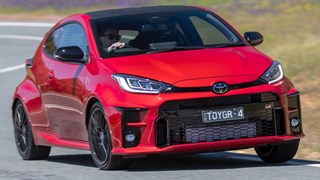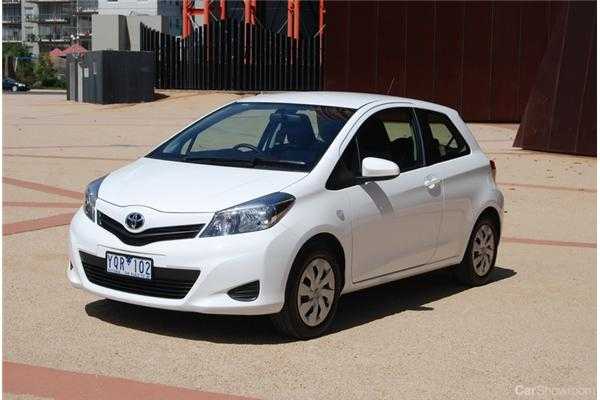There are important cars and there are crucial cars. In the last few months Toyota has launched two all-new models which definitely fall into the latter category – the all-new Yaris compact hatchback and Camry mid-size sedan.
On the one hand, Australia’s strong dollar is making life difficult for Camry’s export program, but the currency has helped Toyota to load-up the Yaris with massive amounts of standard kit while for the most part peg sticker prices to around the same dollars as 1999 – 13 years ago…and that’s impressive.
That also shows how tough and competitive our compact car market segment has become.
Toyota Yaris Overview
For the first time in living memory, Toyota is fighting back. No, the Japanese giant is hardly on its knees, just the combined effects of the media-frenzy-recalls in North America, the GFC and most recently the earthquake/tsunami in Japan all slowed Toyota’s momentum in 2011.
Cue the all-new Toyota Yaris launched late last year. Growth in compact car sales is a world-wide phenomenon and the Yaris is crucial for Toyota’s success, particularly in Europe.
We’ve just spent a week in the mid-range Toyota YRS three-door manual (retail price $16,890).
Knowing how important the light car segment is, Toyota has flexed its muscles with the all-new Yaris – looks, driving dynamics, specifications and, most importantly, pricing are all spot-on.
Toyota Yaris Engine
Toyota stuck with the 1.3-litre and 1.5-litre powerplants for the all-new Yaris. So our YRS model was fitted with the 80kW/141Nm 1.5-litre, driving through a five-speed manual transmission.
Those figures certainly place the Yaris at the sharp end of the performance field for compact cars although, like many contemporary four-cylinder engines tuned for optimized fuel consumption, mid-range torque is a tad flat.
Fuel consumption for our Toyota Yaris 1.5-litre five-speed is rated at 5.8l/100kms
Toyota Yaris The Interior
A discernible lift in material quality and tactile elements allows the all-new Toyota Yaris to really advance over its predecessor. And owners of the previous generation will immediately pick the end of the central-mounted digital speedometer (replaced by nice-looking conventional gauges).
Everyone will appreciate the improved angle of the steering wheel (it’s more vertical so less truck-like) which is now also rake and reach adjustable.
Front seats are massively improved over the previous Yaris.
Our YRS model boasted the colour touch-screen audio system with USB/iPod connectivity and streaming.
Thanks to extra length in the wheelbase, all-new Toyota Yaris delivers better interior space (wider and more leg-room). We reckon rear seat passengers get better foot space too in the Yaris than in most other compact car models and access to the seat is reasonably straight-forward.
Luggage space is also up – 145mm longer and capacity up to segment-best 286-litres.
Toyota Yaris Exterior & Styling
As you may recall, the previous generation Toyota Yaris was an evolution of the rather simplistic Toyota Echo. Now days, the compact car segment has become so complex and competitive, Toyota needed a fresh approach and the world’s number one car-maker has responded with an all-new Yaris sophisticated and engaging to look at.
Maybe it’s evolutionary and it’s certainly typically Toyota conservative, but park the all-new Yaris next to its predecessor and you’ll get the point…
The nose adopts a new, angular look with a pronounced snout and the headlights - hardly shrinking violets in the previous model - seem larger and sharper. The side profile has an upward slope for the glasshouse and waistline creases, while the rear adopts a bootlid-mounted number plate, modern tail-lights and more curvaceous hatch.
The three-door model as tested is distinguished by a forward-sloping C-pillar.
Toyota Yaris On The Road
When Toyota staged the national media preview of the all-new Yaris, the plan called for highlighting the firmer/sportier chassis dynamics credited to firmer springs all-round and Australian calibration of the electric power steering system. In fact the test route then was not far from the roads used frequently by the Car Showroom team when we do our high-speed ride/handling evaluations.
This time we put our Toyota Yaris YRS three-door through our normal week-long test procedure. Sure, over those rural routes we again gleaned the much-improved chassis.
In fact, we’ve reached the conclusion that, all things considered, a good torsion beam rear suspension like the Toyota Yaris these days stakes a claim to being the small car suspension design preferred by enthusiast drivers.
Combine that with Toyota Yaris’ tauter spring rates (18 per cent stiffer front and 26 per cent stiffer rear) plus the Aussie power steering calibration development and the Yaris proved surprisingly sporty over our high-speed roads. Nice grip from the Bridgestone low rolling resistance tyres, working with precise turn-in, a compliant front-end and impressive overall balance.
Just as marked an improvement can be chalked-up to all-new Toyota Yaris in the refinement department. Wind noise, road noise and NVH are significantly better than the superseded Yaris – they needed to be as rival light cars too have made significant improvements in this area.
In the city, of course the Toyota Yaris excelled, and – astonishingly – not one Car Showroom team member complained about driving the five-speed manual in the peak hour crawl…shows Toyota has the light feel of clutch and transmission spot-on. And Yaris’ minute 9.4-metre turning circle just snickered at our tight CBD carpark.
Toyota Yaris Challenges
While some may call it a ‘challenge’, others call it a ‘Toyota Strength’. Let’s put it this way: we like the much-improved exterior and interior style of the all-new Yaris, but when parked alongside rivals like the Fiord Fiesta and Kia Rio, the Yaris does look conservative.
Toyota Yaris Verdict
In 2012, Toyota Yaris and Mazda2 look set to continue slugging it out for overall honours in light car segment sales (in January the difference between the two was just 272 vehicles). You can be sure deals will be intense amongst individual dealers when you start shopping.
The all-new Yaris is unquestionably very good and, where even fierce rivals must grudgingly concede some kudos to Toyota, is the pricing structure for the new Yaris range. While the three-door YRS model we tested was the only variant of the new range to increase in price, the dollars moved north by just $500, but the extra kit included as standard amounts to more than $850…so YRS three-door buyers are still $350 in front.
Compact cars are where it’s at globally and Toyota has earmarked the Yaris for success not only here in Australia, but also – crucially – in Europe. So to the sharp price, you can also add the specifications, the looks and the driving dynamics.
Toyota Yaris The Competition
Gee the Australian market is overflowing with great compact cars these days. Car Showroom’s favourite is the Ford Fiesta, but the German Ford is only sold as a five-door hatchback or sedan – so no three-door to rival the Toyota Yaris YRS tested here. Still at $16,990, the Fiesta CL five-door has lots of appeal.
Kia has just updated its good-looking Rio range to include three-door hatchbacks and four-door sedans. At $15,290, the Kia Rio three-door S (six-speed manual) is overshadowed by Toyota Yaris YRS’ 1.5-litre (80kW/141Nm to 79kW/135Nm) and doesn’t have standard cruise control, but Rio has a more sporty driving dynamic, an up-market interior and undercuts the Yaris YRS’ sticker ($16,890).
Thanks to the latest Polo, Volkswagen has been forced to extend the wing of its Wolfsburg, Germany HQ which houses ‘Car Of The Year’ trophies from around the world. Like the Kia Rio, Polo too is a sharp tool in the twisty stuff and Volkswagen has it handily priced at $16,690 for the entry-grade Trendline three-door five-speed manual. But do a detailed specification comparison if shopping against Toyota’s well-equipped YRS grade Yaris.
Mazda has sharpened the offering of its base-model Mazda2 Neo (starts at $15,790). In terms of driving dynamics the new Toyota Yaris now rivals the previous benchmark-setting Mazda2.
Hyundai i20 is slickly priced at $15,490 for the ‘Active’ three-door manual. With 74kW/136Nm, the i20’s 1.4-litre is in the mix and Hyundai’s stylists have upped their games particularly inside – they had to because their colleagues at Kia did a super job with the Rio.
Suzuki’s latest Swift is definitely worth a look ($15,990 for GA manual). The 70kW/130Nm 1.4-litre engine is out-muscled by the 1.5-litre in Toyota Yaris YRS, but compared to the old days, Suzuki now has high-standard build quality nailed.


























